Intelligent Security Model for Password Generation and Estimation Using Hand Gesture Features
Abstract
1. Introduction
- Information-gain-based feature selection is used to reduce the feature size of the MNIST dataset from 784 to 60 features.
- This paper devises an effective hand gesture recognition using an ensemble learning approach to contribute to the process of generating very strong, hard-to-break, and memorable passwords.
- We apply the sampling techniques to the password strength dataset to deal with an imbalanced class.
- Four well-known classifiers (MLP, SVM, RFT, and AdaBoost) are trained to evaluate password strength. It draws a test password similarity with most of the dataset’s weak, medium, and very strong passwords.
- We extract the most important features such as password diversity and entropy from the password strength dataset to improve the accuracy of classifiers.
- The proposed mechanism makes it easier for the user to create strong and memorable passwords and also provides a mechanism for checking passwords at the same time. Compared with previous work, we find that the system trains hand gestures and passwords with high accuracy.
2. Related Work
2.1. Password Generation
2.2. Password Strength Estimation
2.3. The Applications of Intelligent Data Security
3. Datasets
3.1. Sign Language Dataset
3.2. Password Strength Dataset
4. Methods
- A hand gesture recognition model using an ensemble learning approach to contribute to the process of generating passwords.
- A password strength checking model using an ensemble learning approach to estimate the strength of passwords.
- The user tries to choose at least four different signs through hand gestures.
- After the hand gesture classification, the sign prediction process tries to predict the label for each user’s hand motion.
- Similar features to predicted motion will be retrieved from the training MNIST images dataset and then passed to the password generator.
- The password generator generates a new password depending on each user’s motion features. The password generator has two possible inputs: the label for each user’s hand motion and similar features to predicted motion.
- After the classification of password strength, a new password is passed to the prediction process of the password to estimate its strength. If the new password’s strength is either medium or weak, the system will reject it and generate a new password; otherwise, the proposed approach will accept it.
4.1. The Proposed Password Generation Using Ensemble Learning
4.1.1. Feature Selection Method
4.1.2. Hand Gesture Classifiers
4.1.3. Hand Gesture Recognition (Sign Prediction)
4.1.4. Proposed Password Generation
4.2. The Proposed Password Strength Estimation Using Ensemble Learning
4.2.1. Handling Imbalanced Dataset
4.2.2. Proposed Feature Extraction Method
4.2.3. Password Strength Classifiers
4.2.4. Password Strength Estimation (Prediction)
5. Results and Discussion
5.1. The Proposed Password Strength Estimation Using Ensemble Learning
5.2. Performance Comparison of Hand Gesture Recognition with State of the Art
5.3. Performance Assessment of Multiple Classifiers for Password Strength Estimation
5.4. Performance Comparison of Proposed Password Strength Estimation with State of the Art
5.5. The Analysis of Proposed Password Generation and Strength Estimation
6. Conclusions
Author Contributions
Funding
Institutional Review Board Statement
Informed Consent Statement
Data Availability Statement
Conflicts of Interest
References
- Adams, A.; Sasse, M.A. Users Are Not the Enemy. Commun. ACM 1999, 42, 40–46. [Google Scholar] [CrossRef]
- Riley, C.; Buckner, K.; Johnson, G.; Benyon, D. Culture & Biometrics: Regional Differences in the Perception of Biometric Authentication Technologies. AI Soc. 2009, 24, 295–306. [Google Scholar]
- Yang, G.-C.; Kim, H. A New Graphical Password Scheme Based on Universal Design. J. Digit. Converg. 2014, 12, 231–238. [Google Scholar] [CrossRef][Green Version]
- Yang, G.-C.; Oh, H. Implementation of a Graphical Password Authentication System ‘PassPositions’. J. Image Graph. 2018, 6, 117–121. [Google Scholar] [CrossRef]
- Jiránek, K. Rule-Based Password Generation. 2017. Available online: https://www.google.com/url?sa=t&rct=j&q=&esrc=s&source=web&cd=&cad=rja&uact=8&ved=2ahUKEwjVypHJgeD6AhXlgFYBHeUUAmE-QFnoECBMQAQ&url=https%3A%2F%2Fexcel.fit.vutbr.cz%2Fsubmissions%2F2017%2F020%2F20.pdf&usg=AOvVaw3-bh39ob4Aqi102Mq-dMp8 (accessed on 15 August 2022).
- Deng, G.; Yu, X.; Guo, H. Efficient Password Guessing Based on a Password Segmentation Approach. In Proceedings of the 2019 IEEE Global Communications Conference (GLOBECOM), Waikoloa, HI, USA, 9–13 December 2019; pp. 1–6. [Google Scholar]
- Xia, Z.; Yi, P.; Liu, Y.; Jiang, B.; Wang, W.; Zhu, T. GENPass: A Multi-Source Deep Learning Model for Password Guessing. IEEE Trans. Multimed. 2019, 22, 1323–1332. [Google Scholar] [CrossRef]
- Kumar, B.P.; Reddy, E.S. An Efficient Security Model for Password Generation and Time Complexity Analysis for Cracking the Password. Int. J. Saf. Secur. Eng. 2020, 10, 713–720. [Google Scholar] [CrossRef]
- Murmu, S.; Kasyap, H.; Tripathy, S. PassMon: A Technique for Password Generation and Strength Estimation. J. Netw. Syst. Manag. 2022, 30, 1–23. [Google Scholar] [CrossRef]
- Hingmire, A.; Saliya, S. A Multimodal Metric for Password Strength Estimation. Int. J. Recent Trends Eng. Res. 2017, 3, 21–30. [Google Scholar]
- Rodwald, P. Using Gamification and Fear Appeal Instead of Password Strength Meters to Increase Password Entropy. Sci. J. Polish Nav. Acad. 2019, 60, 17–33. [Google Scholar] [CrossRef]
- Galbally, J.; Coisel, I.; Sanchez, I. A Probabilistic Framework for Improved Password Strength Metrics. In Proceedings of the 2014 International Carnahan Conference on Security Technology (ICCST), Rome, Italy, 13–16 October 2014; pp. 1–6. [Google Scholar]
- Ma, J.; Yang, W.; Luo, M.; Li, N. A Study of Probabilistic Password Models. In Proceedings of the 2014 IEEE Symposium on Security and Privacy, Rome, Italy, 13–16 October 2014; pp. 689–704. [Google Scholar]
- Bonneau, J. Statistical Metrics for Individual Password Strength. In Proceedings of the International Workshop on Security Protocols, Cambridge, UK, 12–13 April 2012; pp. 76–86. [Google Scholar]
- Cui, X.; Li, X.; Qin, Y.; Yong, D. A Password Strength Evaluation Algorithm Based on Sensitive Personal Information. In Proceedings of the 2020 IEEE 19th International Conference on Trust, Security and Privacy in Computing and Communications (TrustCom), Guangzhou, China, 29 December 2020–1 January 2021; pp. 1542–1545. [Google Scholar]
- Egelman, S.; Sotirakopoulos, A.; Muslukhov, I.; Beznosov, K.; Herley, C. Does My Password Go up to Eleven? The Impact of Password Meters on Password Selection. In Proceedings of the SIGCHI Conference on Human Factors in Computing Systems, Paris, France, 27 April 2013–2 May 2013; pp. 2379–2388. [Google Scholar]
- Florêncio, D.; Herley, C.; Van Oorschot, P.C. An Administrator’s Guide to Internet Password Research. In Proceedings of the 28th Large Installation System Administration Conference (LISA14), Seattle, WA, USA, 9–14 November 2014; pp. 44–61. [Google Scholar]
- Grassi, P.A.; Garcia, M.E.; Fenton, J.L. Draft Nist Special Publication 800-63-3 Digital Identity Guidelines; NIST: Los Altos, CA, USA, 2017. [Google Scholar]
- Wheeler, D.L. Zxcvbn:{Low-Budget} Password Strength Estimation. In Proceedings of the 25th USENIX Security Symposium (USENIX Security 16), Austin, TX, USA, 10–12 August 10 2016; pp. 157–173. [Google Scholar]
- Rathi, R.; Visvanathan, P.; Kanchana, R.; Anand, R. A Comparative Analysis of Soft Computing Techniques for Password Strength Classification. In Proceedings of the 2020 International Conference on Emerging Trends in Information Technology and Engineering (ic-ETITE), Vellore, India, 24–25 February 2020; pp. 1–3. [Google Scholar]
- Farooq, U. Real Time Password Strength Analysis on a Web Application Using Multiple Machine Learning Approaches. Int. J. Eng. Res. Technol. 2020, 9, 359–364. [Google Scholar]
- Nam, S.; Jeon, S.; Kim, H.; Moon, J. Recurrent Gans Password Cracker for Iot Password Security Enhancement. Sensors 2020, 20, 3106. [Google Scholar] [CrossRef] [PubMed]
- Mariappan, D.B.; Parihar, H.; Gautham, M.K.; Verma, D.C. Smart Office Area Monitoring & Control Based on IOT. In Proceedings of the 2020 2nd International Conference on Advances in Computing, Communication Control and Networking (ICACCCN), Greater Noida, India, 18–19 December 2020; pp. 450–453. [Google Scholar]
- CAI, J.; LI, R. New Dynamic Password Authentication Based on Smart Card and Fingerprint. J. Comput. Appl. 2008, 28, 1167–1169. [Google Scholar] [CrossRef]
- Kook, J. Design and Implementation of a OTP-Based IoT Digital Door-Lock System and Applications. Int. J. Eng. Res. Technol. 2019, 12, 1841–1846. [Google Scholar]
- Zhang, M.; Gao, C.; Xu, S. Dialect Password Recognition In Smart Home Based On Convolutional Neural Network. In Proceedings of the 2022 4th International Conference on Intelligent Control, Measurement and Signal Processing (ICMSP), Hangzhou, China, 8–10 July 2022; pp. 812–815. [Google Scholar]
- Banerjee, S.; Chowdhury, E.; Sikder, C.; Sarkar, D.; Sarbadhikary, R. Arduino UNO and GSM Based Real-Time Home Security System Using Self-Generated Password Protection. System 2019, 4, 8827. [Google Scholar] [CrossRef]
- Alajmi, M.; Elashry, I.; El-Sayed, H.S.; Faragallah, O.S. A Password-Based Authentication System Based on the CAPTCHA AI Problem. IEEE Access 2020, 8, 153914–153928. [Google Scholar] [CrossRef]
- Chen, D.; Zhao, H. Data Security and Privacy Protection Issues in Cloud Computing. In Proceedings of the 2012 International Conference on Computer Science and Electronics Engineering, Hangzhou, China, 23–25 March 2012; Volume 1, pp. 647–651. [Google Scholar]
- Li, B.; Feng, Y.; Xiong, Z.; Yang, W.; Liu, G. Research on AI Security Enhanced Encryption Algorithm of Autonomous IoT Systems. Inf. Sci. 2021, 575, 379–398. [Google Scholar] [CrossRef]
- Tecperson Sign Language MNIST. Available online: https://www.kaggle.com/datasets/datamunge/sign-language-mnist (accessed on 1 January 2022).
- Bhavik Bansal Password Strength Classifier Dataset. Available online: https://www.kaggle.com/datasets/bhavikbb/password-strength-classifier-dataset (accessed on 1 February 2022).
- Azhagusundari, B.; Thanamani, A.S. Feature Selection Based on Information Gain. Int. J. Innov. Technol. Explor. Eng. 2013, 2, 18–21. [Google Scholar]
- Taud, H.; Mas, J.F. Multilayer Perceptron (MLP). In Geomatic Approaches for Modeling Land Change Scenarios; Springer: Berlin/Heidelberg, Germany, 2018; pp. 451–455. [Google Scholar]
- Chamasemani FF, S.Y. Multi-Class Support Vector Machine (SVM) Classifiers—An Application in Hypothyroid Detection and Classification. In Proceedings of the 2011 Sixth International Conference on Bio-Inspired Computing: Theories and Applications, Penang, Malaysia, 27–29 September 2011. [Google Scholar]
- Liaw, A.; Wiener, M. Classification and Regression by RandomForest. R News 2002, 2, 18–22. [Google Scholar]
- An, T.-K.; Kim, M.-H. A New Diverse AdaBoost Classifier. In Proceedings of the 2010 International Conference on Artificial Intelligence and Computational Intelligence, Washington, DC, USA, 23–24 October 2010; Volume 1, pp. 359–363. [Google Scholar]
- Demšar, J.; Curk, T.; Erjavec, A.; Gorup, Č.; Hočevar, T.; Milutinovič, M.; Možina, M.; Polajnar, M.; Toplak, M.; Starič, A. Orange: Data Mining Toolbox in Python. J. Mach. Learn. Res. 2013, 14, 2349–2353. [Google Scholar]
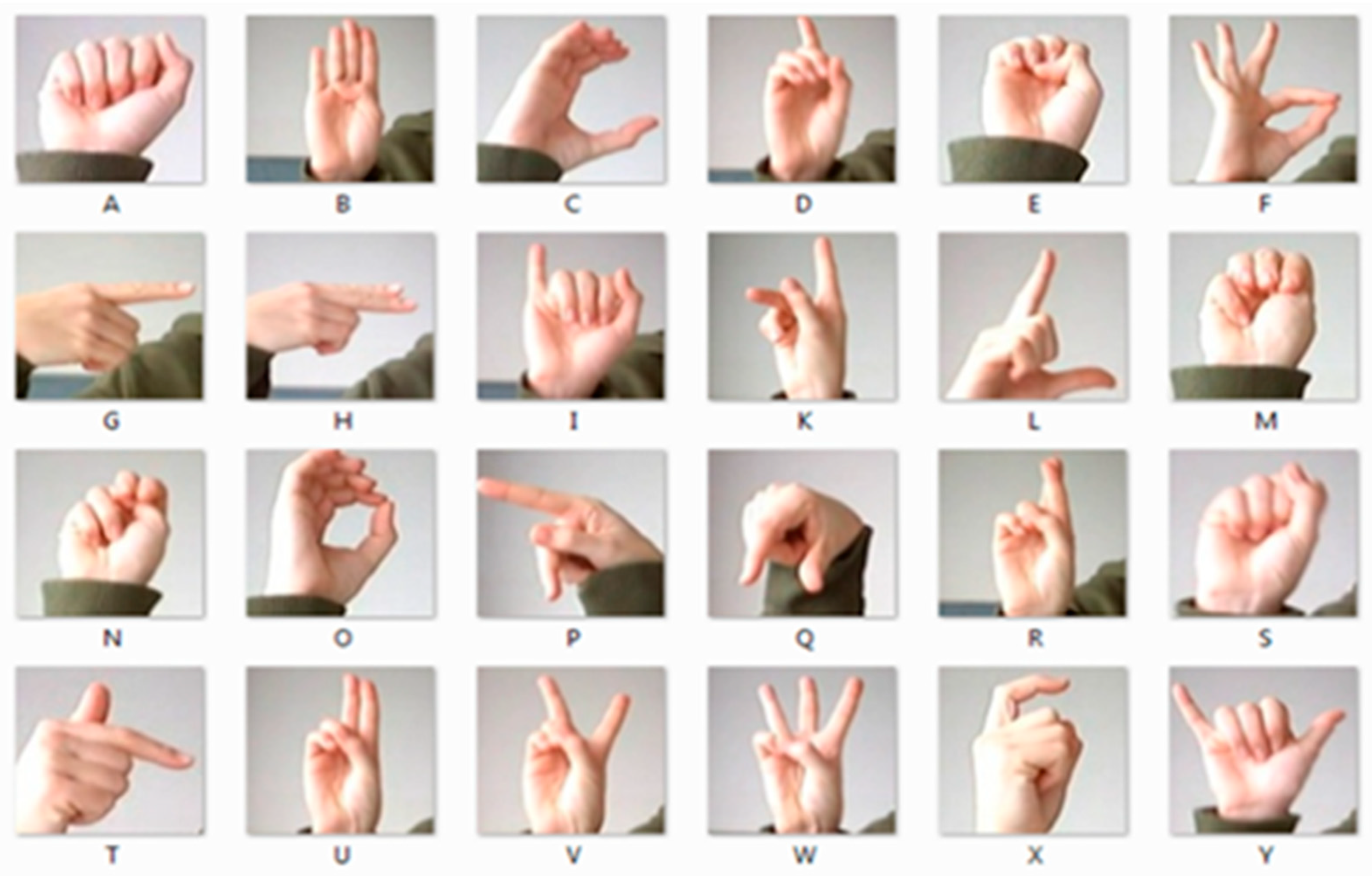
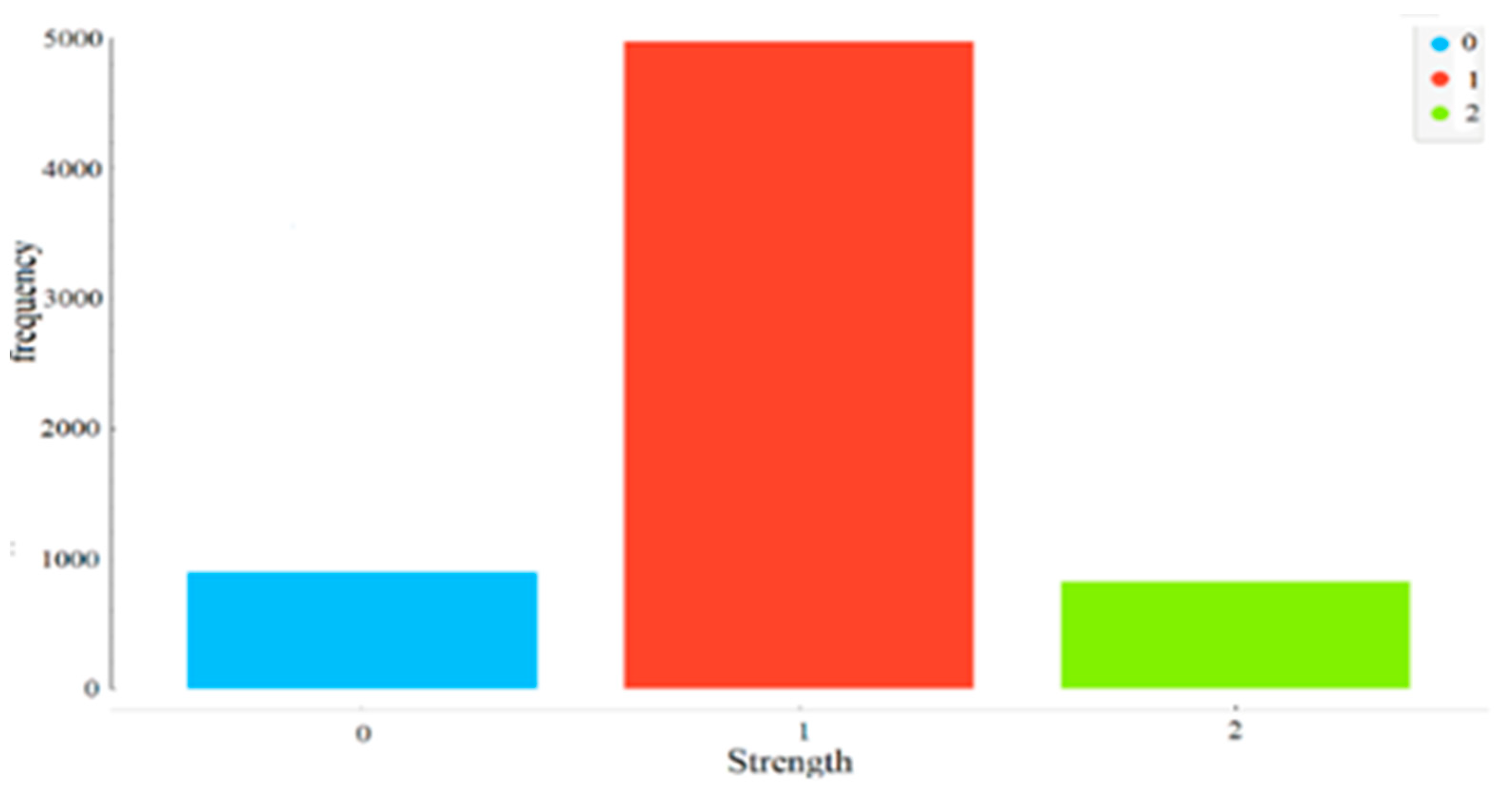
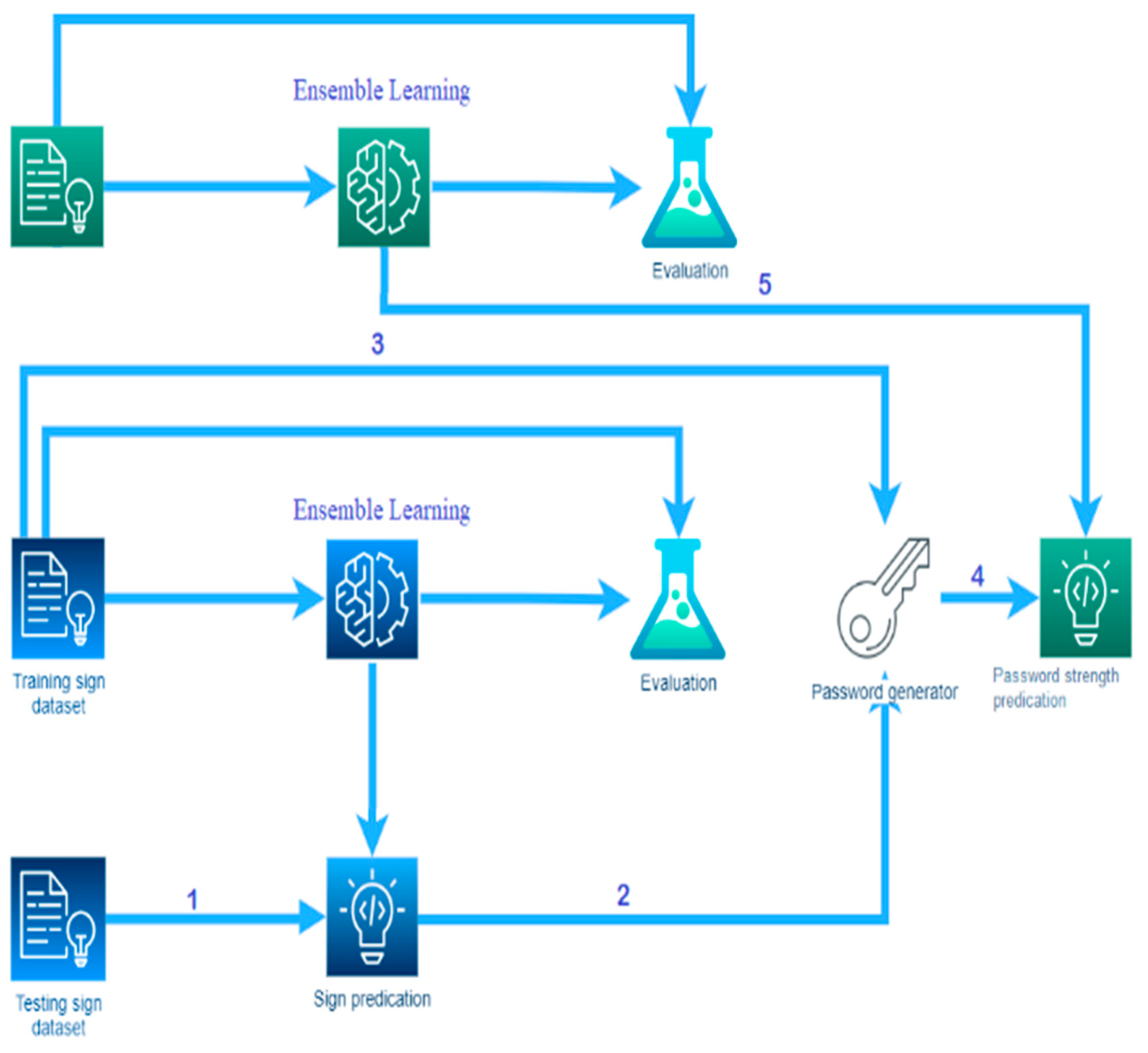
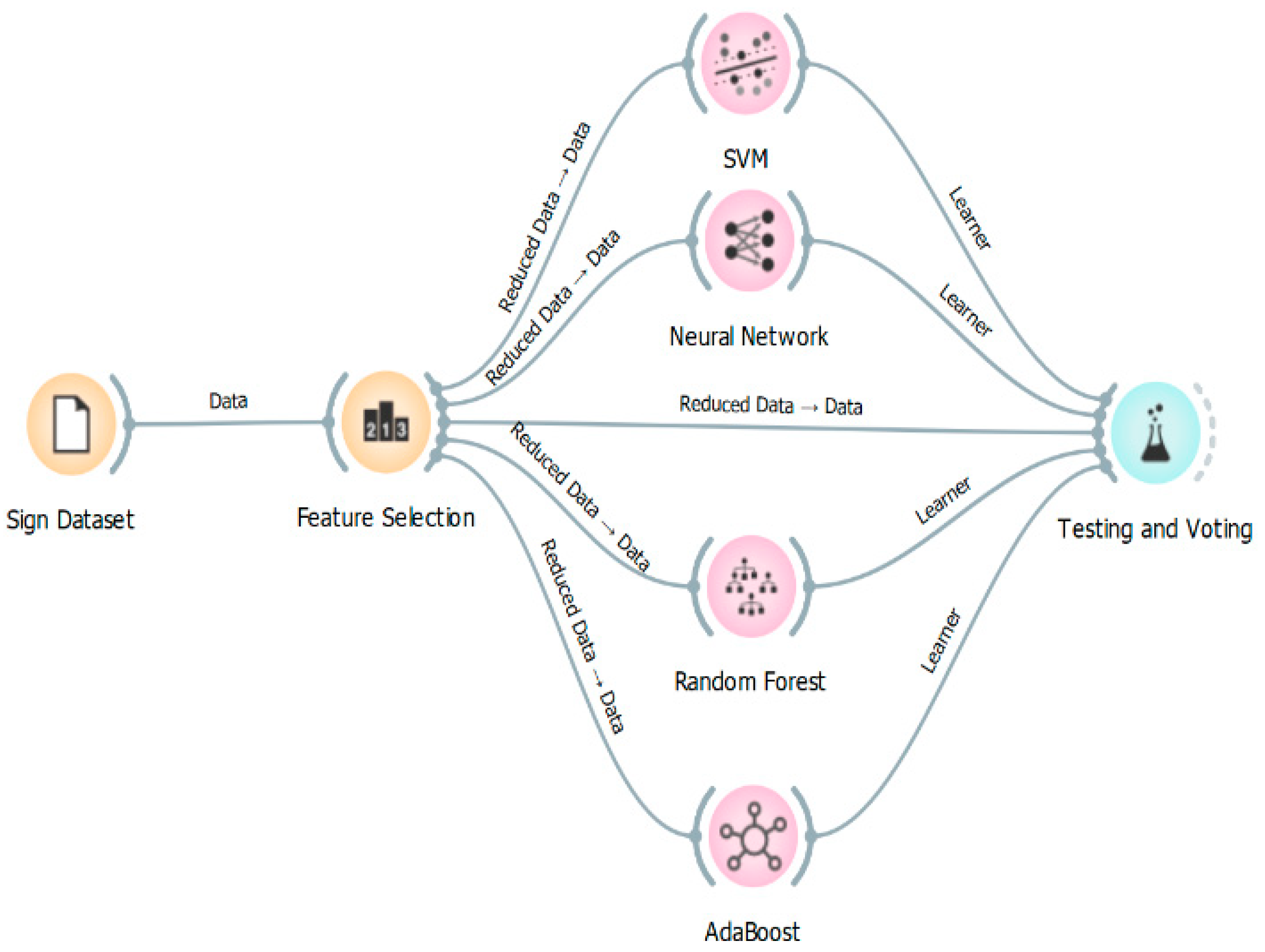
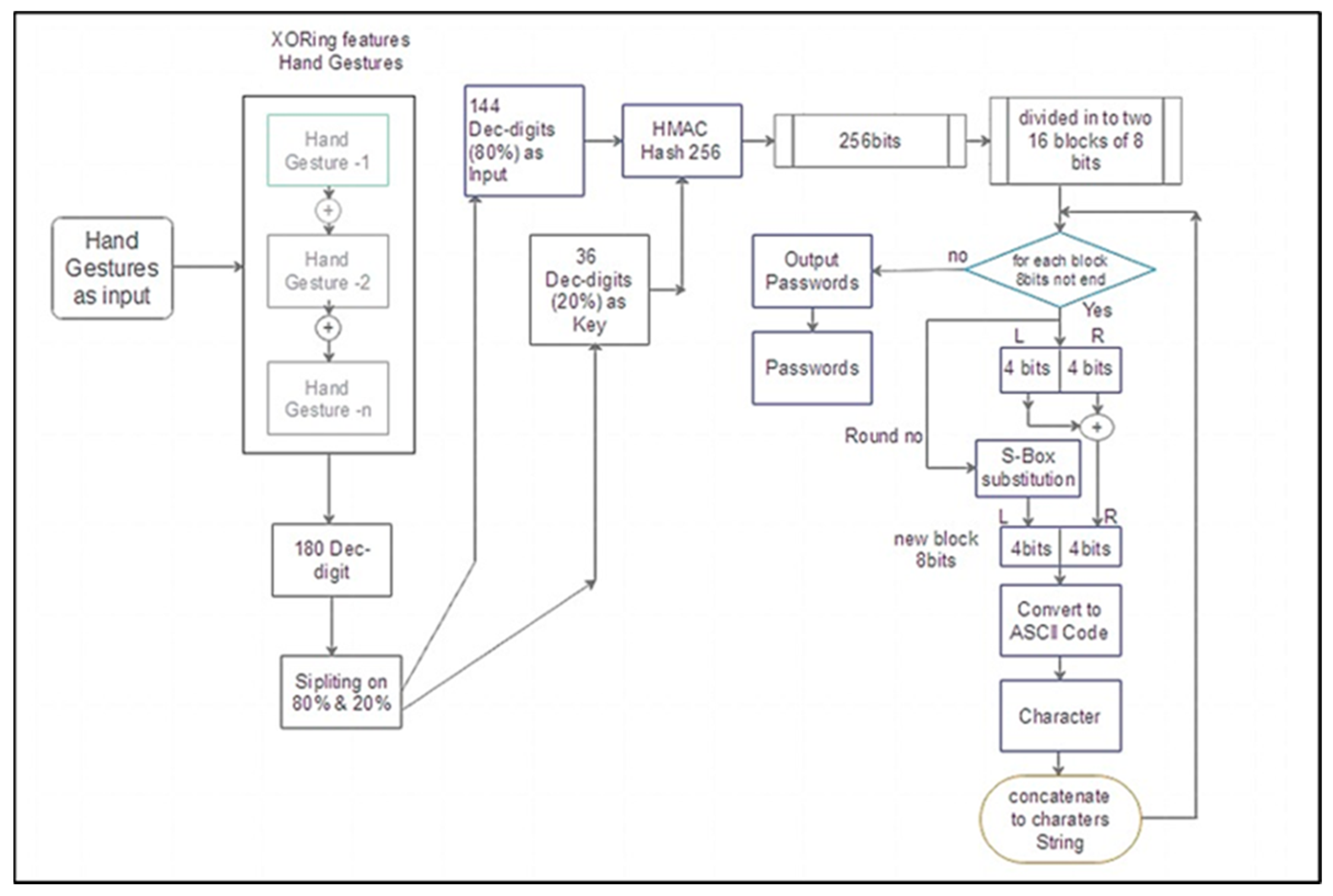
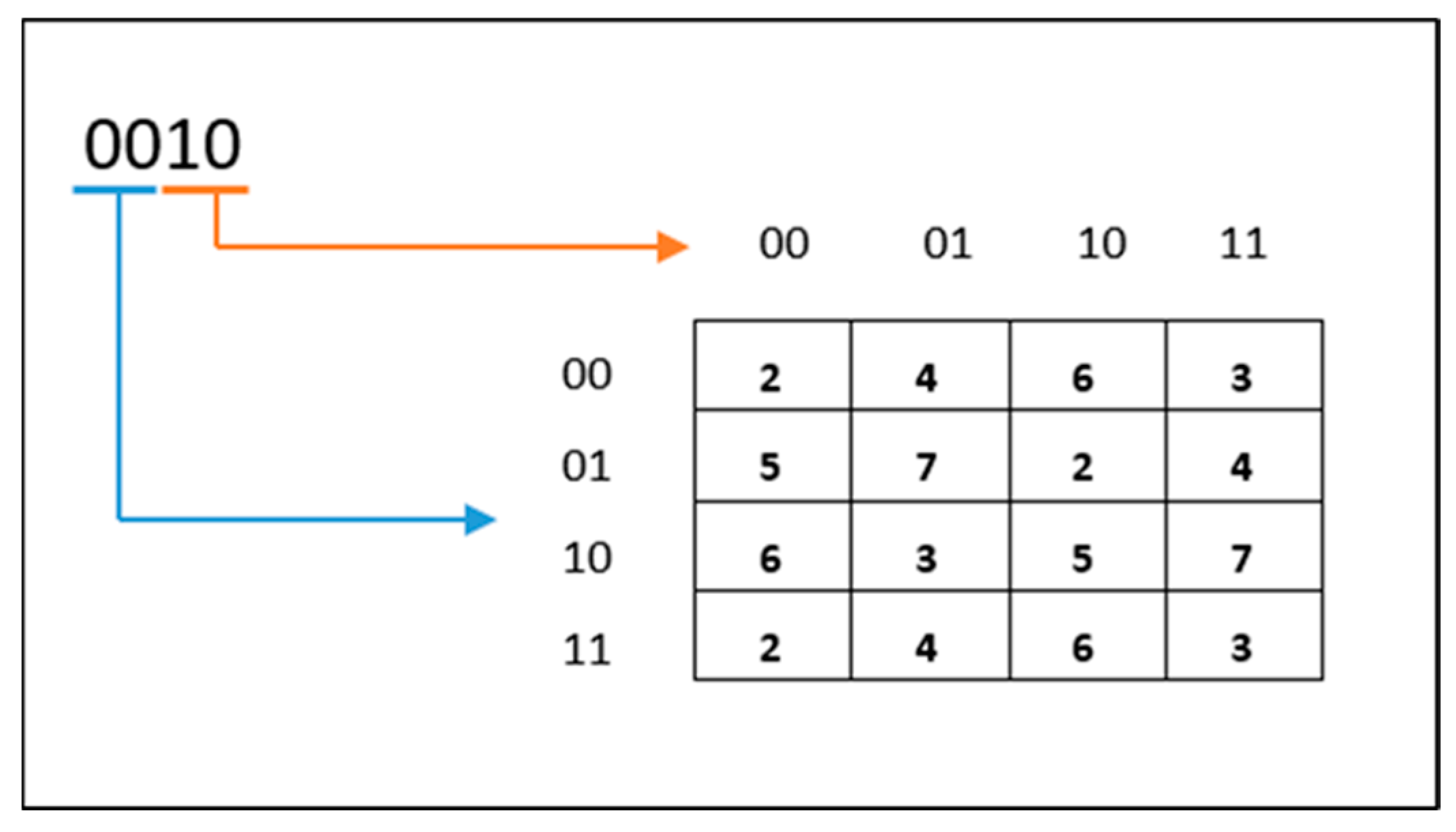
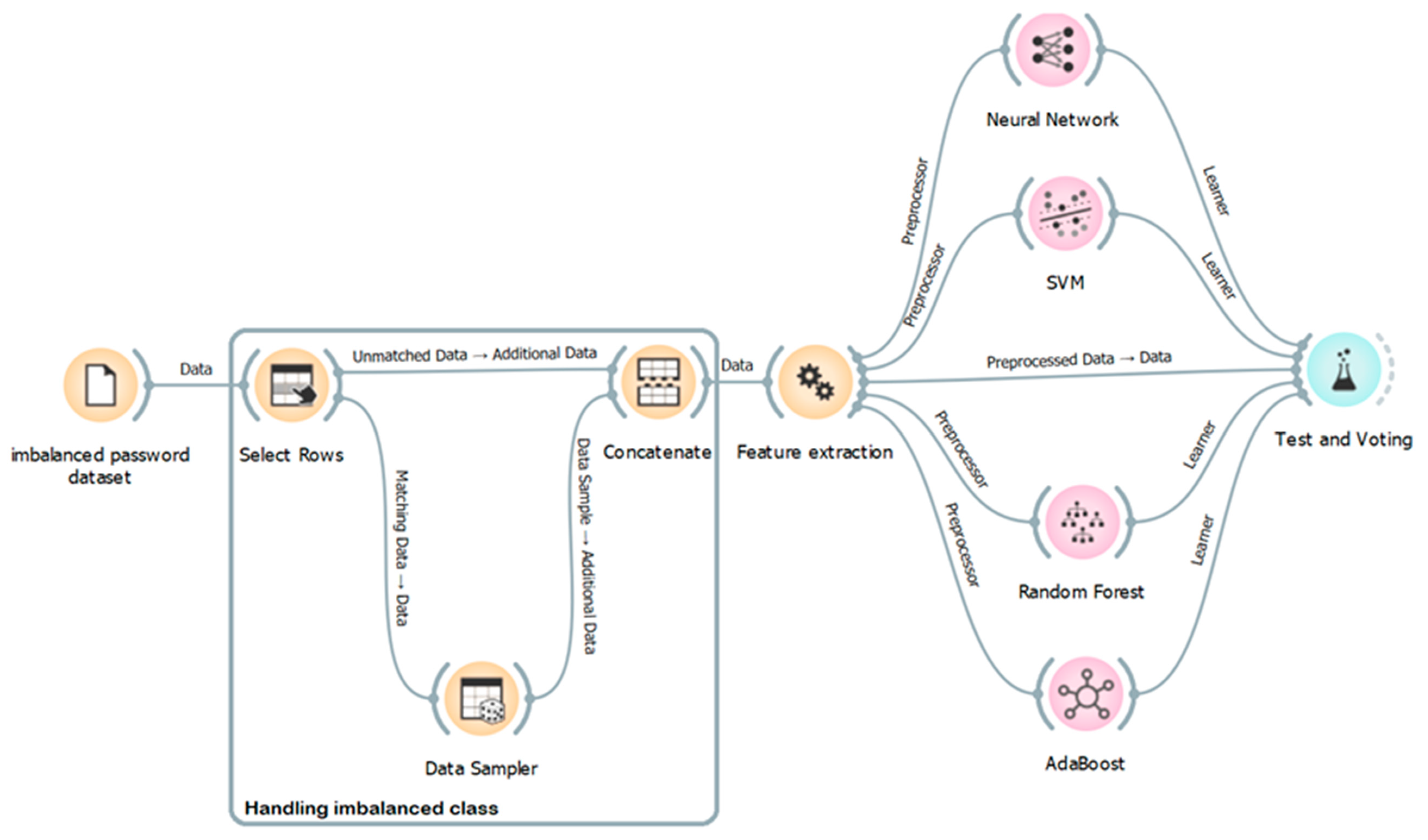
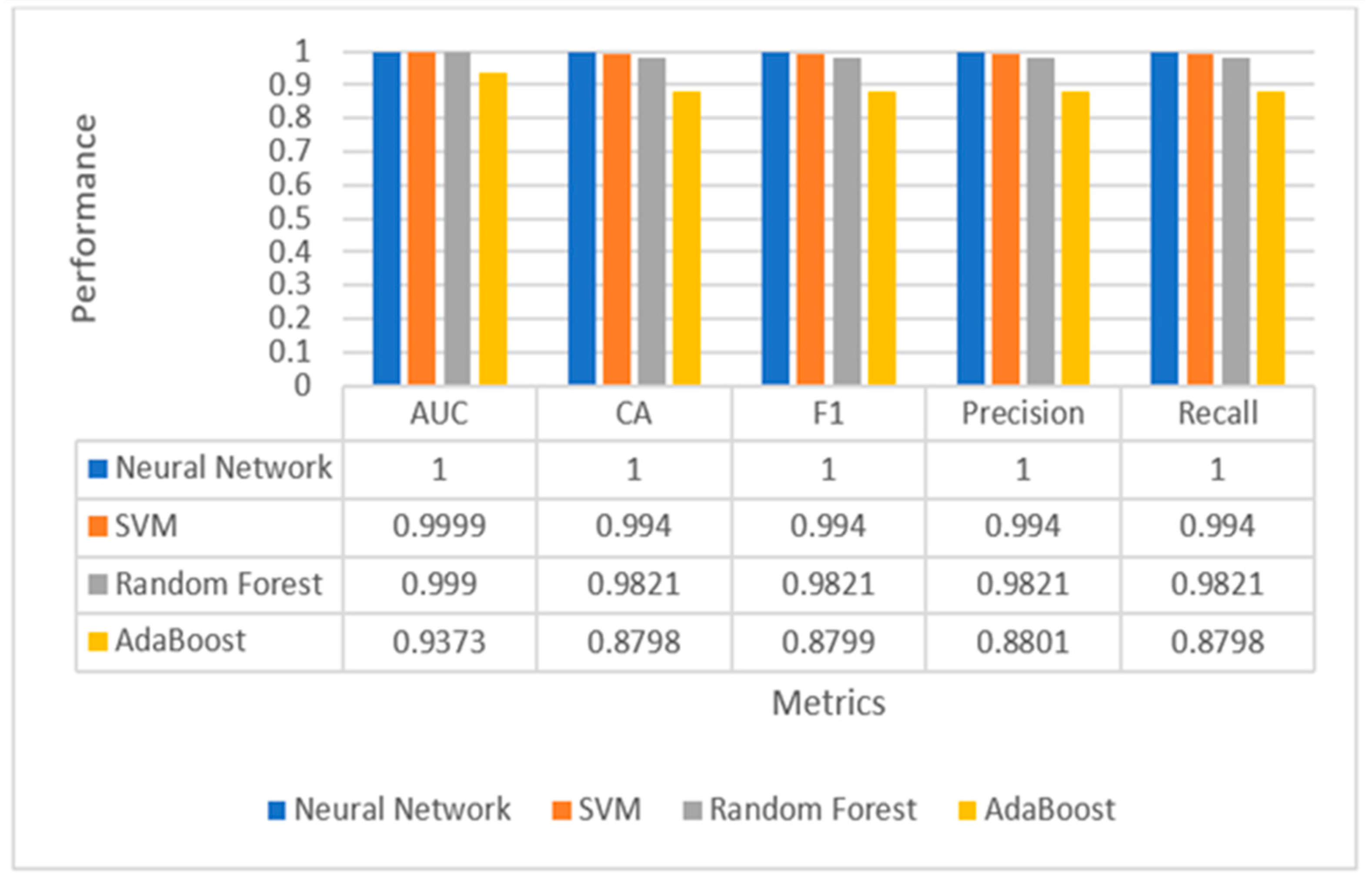
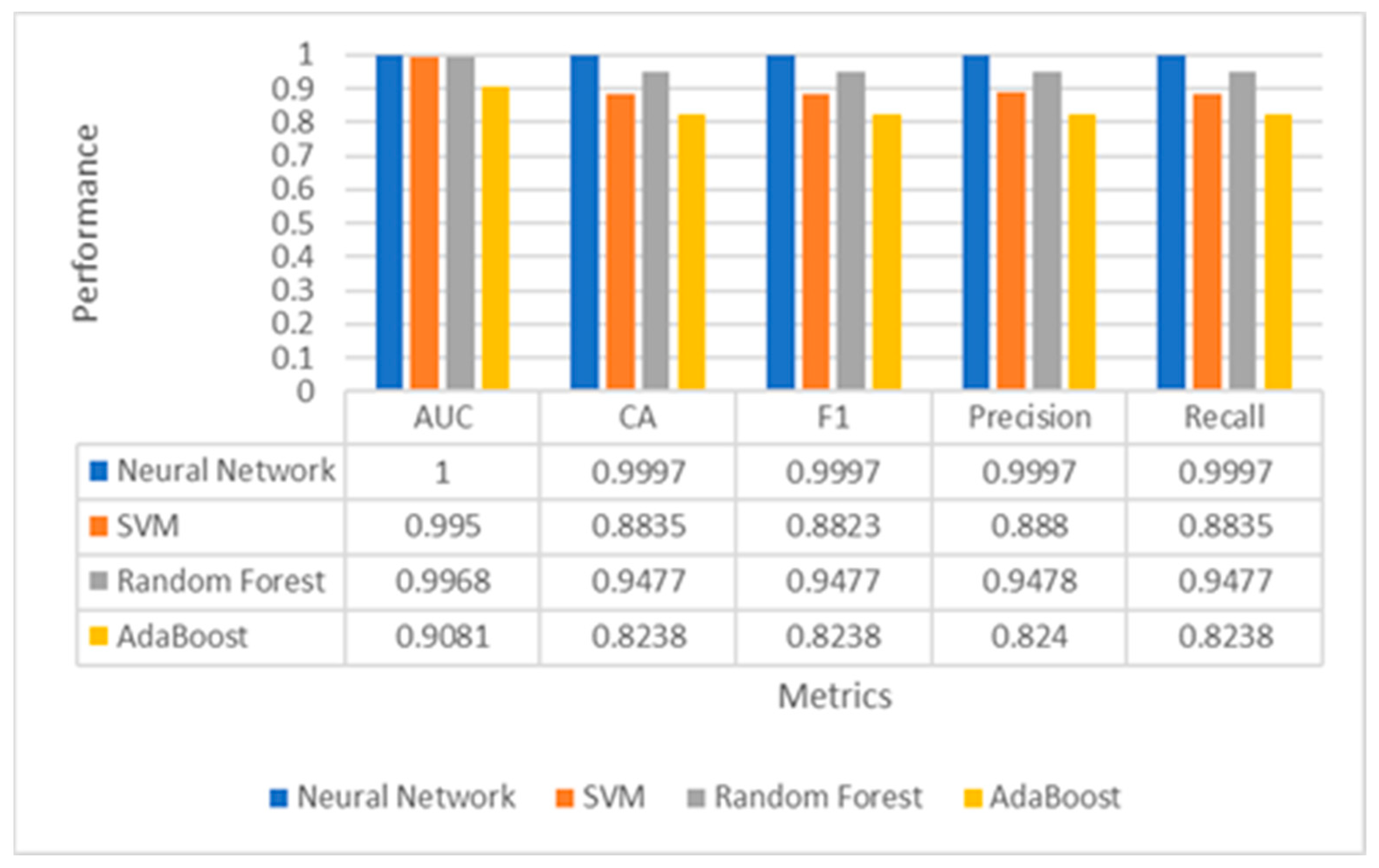
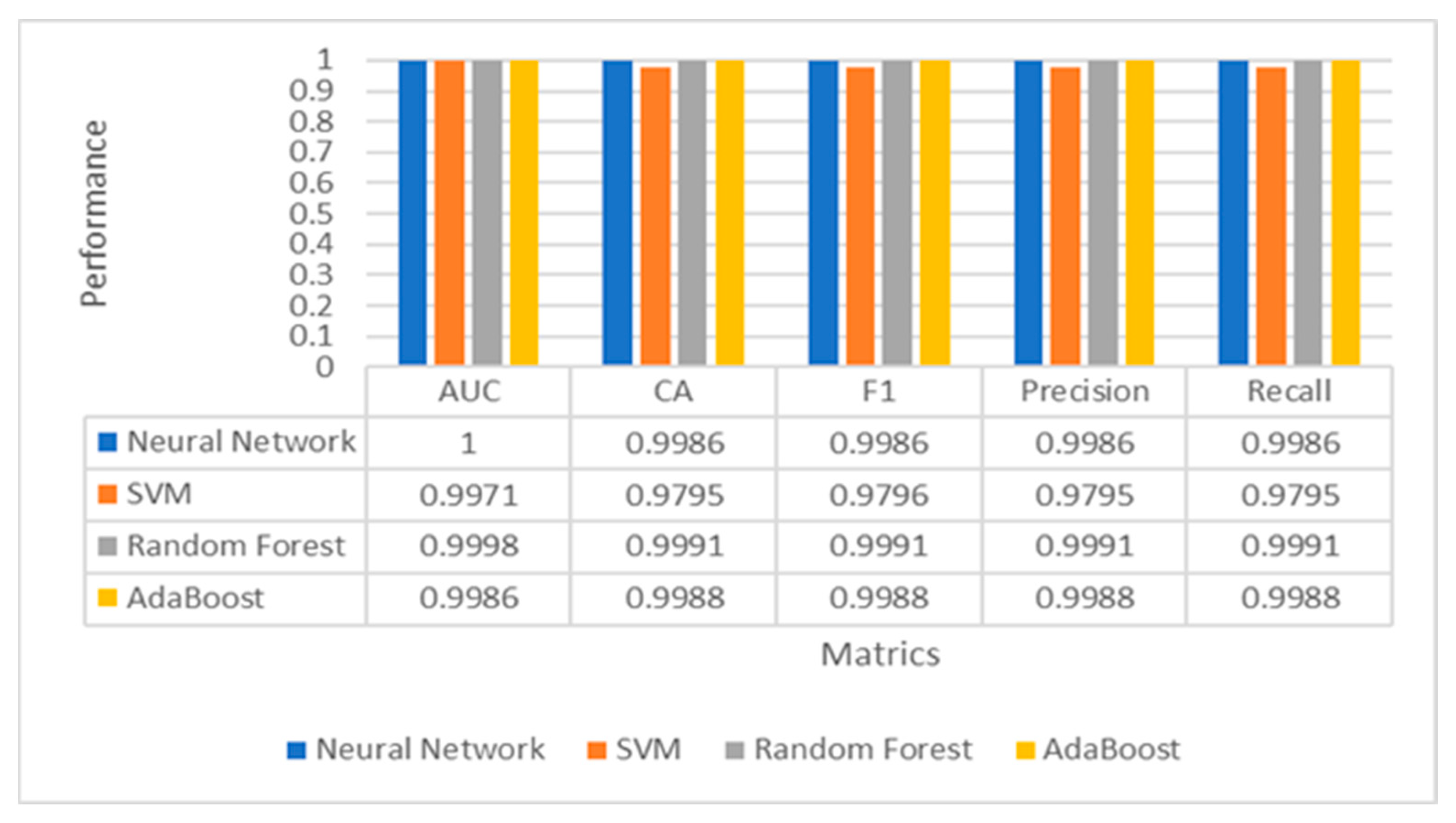
| Classifiers | Key Parameters |
|---|---|
| ANN | Maximum number of iterations: 200 |
| Neurons in hidden layers: 100 | |
| Activation function: ReLu | |
| Solver: Adam | |
| Regularization: 0.0001 | |
| SVM | Iteration limit: 100 |
| Cost value: 1 | |
| Kernel: RBF | |
| Regression loss epsilon (ε): 0.10 | |
| Numerical tolerance: 0.0010 | |
| RFT | Number of trees: 10 |
| Number of attributes at each split: 5 | |
| Individual tree depth limit: 3 | |
| Do not split subset smaller than: 5 | |
| Ada-Boost | Number of estimators: 50 |
| Classification algorithm: SAMME.R | |
| Base estimator: Tree | |
| Learning rate: 1 | |
| Regression loss function: Linear |
| Label | F1 | F2 | … | F60 |
|---|---|---|---|---|
| 0 | 134 | 119 | … | 120 |
| 1 | 224 | 168 | … | 228 |
| 2 | 118 | 109 | … | 130 |
| 3 | 178 | 135 | … | 181 |
| 4 | 212 | 198 | … | 197 |
| 5 | 145 | 143 | … | 141 |
| 6 | 63 | 111 | … | 60 |
| 7 | 110 | 111 | … | 113 |
| 8 | 202 | 188 | … | 187 |
| 10 | 112 | 125 | … | 112 |
| 11 | 43 | 71 | … | 59 |
| 12 | 210 | 222 | … | 200 |
| 13 | 255 | 238 | … | 255 |
| 14 | 63 | 53 | … | 70 |
| 15 | 103 | 101 | … | 118 |
| 16 | 78 | 87 | … | 75 |
| 17 | 172 | 211 | … | 168 |
| 18 | 194 | 196 | … | 204 |
| 19 | 168 | 60 | … | 195 |
| 20 | 94 | 144 | … | 156 |
| 21 | 161 | 138 | … | 171 |
| 22 | 115 | 173 | … | 112 |
| 23 | 99 | 83 | … | 108 |
| 24 | 90 | 100 | … | 87 |
| Id. | Password | Length | No. of Uppercase | No. of Lowercase | No. of Digits | No. of Special Chr. | Diversity | Entropy | Strength |
|---|---|---|---|---|---|---|---|---|---|
| 1. | p2share | 7 | 0 | 6 | 1 | 0 | 3 | 2.8074 | 0 |
| 2. | j09000 | 6 | 0 | 1 | 5 | 0 | 2 | 1.2516 | 0 |
| 3. | 5gzj5uf | 7 | 0 | 5 | 2 | 0 | 4 | 2.5216 | 0 |
| 4. | winxp; | 6 | 0 | 5 | 0 | 1 | 2 | 2.585 | 0 |
| 5. | ZM9199 | 6 | 2 | 0 | 4 | 0 | 2 | 1.7925 | 0 |
| 6. | kzde5577 | 8 | 0 | 4 | 4 | 0 | 2 | 2.5 | 1 |
| 7. | YADHJIGSAWS11 | 13 | 11 | 0 | 2 | 0 | 2 | 3.2389 | 1 |
| 8. | khurram_ | 8 | 0 | 7 | 0 | 1 | 2 | 2.75 | 1 |
| 9. | AS0130066 | 9 | 2 | 0 | 7 | 0 | 2 | 2.4194 | 1 |
| 10. | 123_456_789 | 11 | 0 | 0 | 9 | 2 | 5 | 3.2776 | 1 |
| 11. | !”64~J”bL+^/NGZ$CNfUbE)?Pvapt9 | 30 | 10 | 7 | 3 | 10 | 19 | 4.7069 | 2 |
| 12. | 1q2w3e4r5t6y7u8i9o0P | 20 | 1 | 9 | 10 | 0 | 20 | 4.3219 | 2 |
| 13. | 248sUqiFEJuRag | 14 | 5 | 6 | 3 | 0 | 8 | 3.8074 | 2 |
| 14. | 678CuLeJAPazob | 14 | 5 | 6 | 3 | 0 | 7 | 3.8074 | 2 |
| 15. | Me&ren102003000 | 15 | 1 | 4 | 9 | 1 | 5 | 2.7396 | 2 |
| Iteration | SVM | MLP | ||||||||
|---|---|---|---|---|---|---|---|---|---|---|
| Train Time (s) | Test Time (s) | AUC | CA | F1 | Train Time (s) | Test Time (s) | AUC | CA | F1 | |
| 20 | 97.020 | 34.977 | 0.9772 | 0.6763 | 0.6739 | 44.769 | 0.567 | 1 | 0.9986 | 0.9986 |
| 40 | 171.315 | 50.169 | 0.9858 | 0.7671 | 0.7641 | 86.629 | 0.506 | 1 | 0.9995 | 0.9995 |
| 60 | 251.76 | 61.165 | 0.9858 | 0.7671 | 0.7641 | 124.953 | 0.607 | 1 | 0.9995 | 0.9995 |
| 80 | 360.076 | 77.605 | 0.9921 | 0.8362 | 0.833 | 178.028 | 0.533 | 1 | 0.9995 | 0.9995 |
| 100 | 365.26 | 76.316 | 0.9948 | 0.8835 | 0.8823 | 212.49 | 0.516 | 1 | 0.9996 | 0.9996 |
| 120 | 445.276 | 90.723 | 0.9948 | 0.8835 | 0.8823 | 216.282 | 0.516 | 1 | 0.9996 | 0.9996 |
| Ref. | Gesture Type | Accuracy (%) |
|---|---|---|
| Jalal, M.A. et al. | 24 ASL gestures | 99.00 |
| Chong, T.-W. et al. | 26 ASL gestures (A–Z) and 36 ASL gestures (A–Z, 0–9) | 93.81 |
| Aly, W. | 24 ASL | 88.70 |
| et al. | 26 English alphabets | 94.34 |
| Das, P. et al. | 26 English alphabets | 95.18 |
| Alon, H.D. et al. | 10 signs of 0 to 9 digits | 87.50 |
| Chavan, S. et al. | 24 ASL gestures | 99.67 |
| our proposed method | 24 ASL gestures | 99.97 |
| our proposed method | 24 ASL gestures | 100.00 |
| Ref. | Classifier | Accuracy (%) | Precision (%) | Recall (%) |
|---|---|---|---|---|
| Farooq, U. [21] | DT | 99 | 98 | 97 |
| NB | 87 | 78 | 81 | |
| LR | 89 | 81 | 84 | |
| RFT | 95 | 94 | 91 | |
| ANN | 92 | 89 | 87 | |
| Rathi, R. et al. [20] | ANN | 77 | - | - |
| LR | 81 | - | - | |
| our proposed method | ANN | 99 | 99 | 99 |
| SVM | 97 | 97 | 97 | |
| RFT | 99 | 99 | 99 | |
| AdaBoost | 99 | 99 | 99 |
| Hand Gestures Selection | Password | Length | No. of Uppercase | No. of Lowercase | No. of Digits | No. of Special Chr. | Diversity | Entropy |
|---|---|---|---|---|---|---|---|---|
| 1,2,3,4 | ,Gc6X~$Cd2Wv*Gk8 | 22 | 5 | 4 | 3 | 10 | 16 | 4 |
| Zp’@d8]u’Na;W}-F | 16 | 4 | 4 | 1 | 7 | 14 | 4 | |
| 10,12,14,16 | ‘Cc<Xp!He=Rz$Lk> | 22 | 5 | 5 | 0 | 12 | 16 | 4 |
| Qr&Mn6_z!Do4Yp.C | 16 | 5 | 5 | 2 | 4 | 16 | 4 | |
| 20,21,22,23 | /Om>\p#@a2Vt’Mm2 | 19 | 3 | 5 | 2 | 9 | 14 | 4 |
| ^q-Ab2P|$Ch>Wv!E | 19 | 5 | 4 | 1 | 9 | 15 | 4 | |
| 1,11,17,19 | .Eg7T{$Fd3Tr/Ln4 | 22 | 5 | 4 | 3 | 10 | 16 | 4 |
| Yv$Ah?Xu(Bd;Xw#M | 16 | 6 | 5 | 0 | 5 | 16 | 4 | |
| 24,2,6,7,8,9 | *Fk3Yv)Ca9Zp+Gc< | 22 | 5 | 5 | 2 | 10 | 16 | 4 |
| Q}.Bf2Px$Eo8[s#O | 16 | 5 | 4 | 2 | 5 | 15 | 4 | |
| 20,24,19,3,6 | #Il:Uy%@m=Q}.@h | 21 | 3 | 4 | 0 | 14 | 13 | 4 |
| 9Pw)@b<S} Gj7Yu’B | 23 | 5 | 4 | 2 | 12 | 17 | 4 | |
| 2,20,15,5 | &Hd0Yy(Ij9Sq,Oj9 | 19 | 5 | 5 | 3 | 6 | 17 | 4 |
| Pp#F‘1Wu&Kg>]{‘H | 16 | 5 | 3 | 1 | 7 | 13 | 4 | |
| 12,13,14,15 | ‘Db4Sw.Lo9^s*Mc4 | 22 | 4 | 5 | 3 | 10 | 17 | 4 |
| \q/Go3\}/Dg4]w&B | 22 | 3 | 4 | 2 | 13 | 15 | 4 | |
| 21,4,3,6,8 | Ak=SwOd1Wx#Ac6V} | 19 | 6 | 5 | 2 | 6 | 16 | 4 |
| *Ea<Ys*F‘3_q(B | 20 | 4 | 3 | 1 | 12 | 15 | 4 | |
| 7,15,16,22,23,17 | &Le4Xu#Oi:P|%Fi: | 19 | 5 | 4 | 1 | 9 | 15 | 4 |
| [z-Jk=_p(@a0\r”K | 19 | 2 | 5 | 1 | 11 | 14 | 4 |
| Hand Gestures Selection | Password | Password Strength Checker | Password Meter | Password Monster | Proposed Model |
|---|---|---|---|---|---|
| 1,2,3,4 | ,Gc6X~$Cd2Wv*Gk8 | Very Strong | Very Strong | Very Strong | Very Strong |
| Zp’@d8]u’Na;W}-F | Very Strong | Very Strong | Very Strong | Very Strong | |
| 10,12,14,16 | ‘Cc<Xp!He=Rz$Lk> | Very Strong | Very Strong | Very Strong | Very Strong |
| Qr&Mn6_z!Do4Yp.C | Very Strong | Very Strong | Very Strong | Very Strong | |
| 20,21,22,23 | /Om>\p#@a2Vt’Mm2 | Very Strong | Very Strong | Very Strong | Very Strong |
| ^q-Ab2P|$Ch>Wv!E | Very Strong | Very Strong | Very Strong | Very Strong | |
| 1,11,17,19 | .Eg7T{$Fd3Tr/Ln4 | Very Strong | Very Strong | Very Strong | Very Strong |
| Yv$Ah?Xu(Bd;Xw#M | Very Strong | Very Strong | Very Strong | Very Strong | |
| 24,2,6,7,8,9 | *Fk3Yv)Ca9Zp+Gc< | Very Strong | Very Strong | Very Strong | Very Strong |
| Q}.Bf2Px$Eo8[s#O | Very Strong | Very Strong | Very Strong | Very Strong | |
| 20,24,19,3,6 | #Il:Uy%@m=Q}.@h | Very Strong | Very Strong | Very Strong | Very Strong |
| 9Pw)@b<S} Gj7Yu’B | Very Strong | Very Strong | Very Strong | Very Strong | |
| 2,20,15,5 | &Hd0Yy(Ij9Sq,Oj9 | Very Strong | Very Strong | Very Strong | Very Strong |
| Pp#F‘1Wu&Kg>]{‘H | Very Strong | Very Strong | Very Strong | Very Strong | |
| 12,13,14,15 | ‘Db4Sw.Lo9^s*Mc4 | Very Strong | Very Strong | Very Strong | Very Strong |
| \q/Go3\}/Dg4]w&B | Very Strong | Very Strong | Very Strong | Very Strong | |
| 21,4,3,6,8 | Ak=SwOd1Wx#Ac6V} | Very Strong | Very Strong | Very Strong | Very Strong |
| *Ea<Ys*F‘3_q(B | Very Strong | Very Strong | Very Strong | Very Strong | |
| 7,15,16,22,23,17 | &Le4Xu#Oi:P|%Fi: | Very Strong | Very Strong | Very Strong | Very Strong |
| [z-Jk=_p(@a0\r”K | Very Strong | Very Strong | Very Strong | Very Strong |
Publisher’s Note: MDPI stays neutral with regard to jurisdictional claims in published maps and institutional affiliations. |
© 2022 by the authors. Licensee MDPI, Basel, Switzerland. This article is an open access article distributed under the terms and conditions of the Creative Commons Attribution (CC BY) license (https://creativecommons.org/licenses/by/4.0/).
Share and Cite
Mahdi, B.S.; Hadi, M.J.; Abbas, A.R. Intelligent Security Model for Password Generation and Estimation Using Hand Gesture Features. Big Data Cogn. Comput. 2022, 6, 116. https://doi.org/10.3390/bdcc6040116
Mahdi BS, Hadi MJ, Abbas AR. Intelligent Security Model for Password Generation and Estimation Using Hand Gesture Features. Big Data and Cognitive Computing. 2022; 6(4):116. https://doi.org/10.3390/bdcc6040116
Chicago/Turabian StyleMahdi, Bashar Saadoon, Mustafa Jasim Hadi, and Ayad Rodhan Abbas. 2022. "Intelligent Security Model for Password Generation and Estimation Using Hand Gesture Features" Big Data and Cognitive Computing 6, no. 4: 116. https://doi.org/10.3390/bdcc6040116
APA StyleMahdi, B. S., Hadi, M. J., & Abbas, A. R. (2022). Intelligent Security Model for Password Generation and Estimation Using Hand Gesture Features. Big Data and Cognitive Computing, 6(4), 116. https://doi.org/10.3390/bdcc6040116







